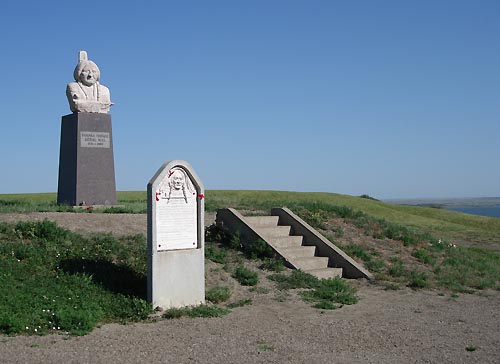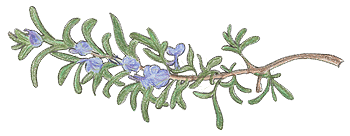Gravesites of Sitting Bull
County: Standing Rock Reservation, North Dakota & South Dakota
Location (North Dakota): Fort Yates
Coordinates (North Dakota): N46o05.361' W100o38.041'
Location (South Dakota): 4 miles S of Hwy 12 (and Grand River Casino) on Hwy 1806

Coordinates (South Dakota): N45o31.015' W100o29.113'
Tatanka Iyotaka, better known by the English translation Sitting Bull, was a Hunkpapa Teton spiritual leader who organized a concerted resistance movement to United States expansion on the treaty-reserved lands of the Lakota in the latter half of the nineteenth century. Years after he surrendered to the United States in 1881, Sitting Bull was shot to death December 15, 1890, by Indian police executing an arrest warrant issued by Indian Agent James McLaughlin to prevent the Lakota icon from attending a Ghost Dance revivalist ceremony.
Sitting Bull was originally buried at Fort Yates, but a group of businessmen from Mobridge, South Dakota, endeavored in the 1950s to move the gravesite to their town to attract tourists. They obtained the support of the son of one of the Indian police officers who arrested Sitting Bull, Clarence Grey Eagle, who was also a relative by marriage of the Lakota leader. Although the Fort Yates gravesite had been woefully neglected by the state, North Dakota officials refused to allow the expatriation of the remains. The South Dakotans then obtained an opinion from the Bureau of Indian Affairs that the descendants of Sitting Bull should determine his final burial site. On April 8, 1953, the South Dakotans used the BIA letter as justification for sending a team of men to dig up Sitting Bull's bones.
Less than five months later, South Dakota dedicated a memorial to Sitting Bull on the site of the relocated remains, sparking a long-running controversy between the two Dakotas and among competing memory groups, including descendants of Sitting Bull. Sculptor Korczak Ziolkowski agreed to create the memorial only after a heated argument over the exploitation of Native Americans, the consent to the project of Sitting Bull's heirs, and a commitment not to exploit the monument as a tourist site. Creating further controversy, the artist boycotted the dedication of the monument because he felt that South Dakota Governor Sigurd Anderson was exploiting the ceremony for political gain.
The monument at Mobridge now stands on a hill overlooking the Missouri River, the bust of Sitting Bull resting atop a nine-foot pillar of granite. The statue is in an isolated area that, while serene and impressive, has suffered from both neglect and vandalism. A competing monument at Fort Yates, a boulder on a platform with a large plaque on the side, was built in an attempt by North Dakota to reclaim part of Sitting Bull's memory. It has since been turned over to the Standing Rock Reservation for management.
The Mobridge site was purchased in 2005 by the Sitting Bull Monument Foundation, which launched a $12.7 million fundraising campaign to create a more fitting memorial. After a life and death marked by controversy and conflict, Sitting Bull's final resting place thus became equally contentious as a result of competition between different memory groups. It seems that at last, both monuments are in the hands of those who genuinely wish to maintain Tatanka Iyotaka's historical legacy.--Research by Curtis Johnson, HIST 489, NDSU, Spring 2007
Recommended Reading
DeWall, Robb. The Saga of Sitting Bull's Bones. Crazy Horse, SD: Korczak's Heritage, 1984.
Utley, Robert M. The Lance and the Shield: The Life and Times of Sitting Bull. New York: Henry Holt, 1993.
Ostler, Jeffrey. The Plains Sioux and U.S. Colonialism From Lewis and Clark to Wounded Knee. New York: Cambridge University Press, 2004.
Sitting Bull Monument Foundation / Fargo Forum Feature Articles / PBS Biography of Sitting Bull / Agent McLaughlin's Report on the Killing of Sitting Bull
| Photo Galleryby Curtis Johnson, 7 April 2007, and Tom Isern, 29 June 2007 |
 |
 |
 |
 |
 |
 |
Video
29 June 2007 |
|---|
Want to talk about this monument, or other heritage sites on the northern plains? Join the discussion on Facebook. Check out the center's Facebook group, Heritage Trails.
 Remembrance in Stone / Center for Heritage Renewal
Remembrance in Stone / Center for Heritage Renewal
|